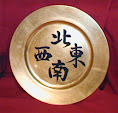Another thread salvaged from the Glorantha G+ community.
Original Post, 17 April:
I have been working on menus... er... encounter charts for my Trolls in Pamaltela game. Since there is little for me to go on, I am wondering what terrestrial analogues to use for flora and fauna. Africa and Australia come to mind, but which regions? Are there other areas I should borrow from? How about epoch? Does the existence of megafauna mammals and dinosaurs point me to points in the past?
A Selection of Comments:
Jeff Richard, 17 April
I tried to give some guidance in the Guide. So for example in Fonrit:
The coastal areas and river valleys are densely populated and fertile. Shovel-tuskers (amebelodon) can be found in the coastal lowlands, and sea-going crocodiles inhabit the rivers.
Or in Umathela:
A wide variety of megafauna can be found in the forests and river valleys of Umathela, including giant sloths, giant armadillos (glyptodons), several species of long-tusk elephants (gomphotheres), running bears (arctodus), shovel-tuskers (amebelodon), sky bulls, and scimitar-toothed cats (homotherium). Alynx live in Vralos, but are rare in Enkloso.
As for in Errinorru, there is just lots of weird stuff, as the Hsunchen entry hints:
Many different Hsunchen peoples live in the jungles of Pamaltela. All are Mesolithic or Neolithic cultures, hunter-gatherers with some forest gardening. They are called Fiwan or the Oldest People by the Doraddi and Fonritians and are believed to have assisted the Creator in making the world. Most are friendly with the Aldryami and most are hostile to outsiders.
The Pujaleg Bat People and Te Huantal Jaguar People are among the best known of the Errinoru Hsunchen, but dozens of Hsunchen groups are known, including the:
• Ayotkulakti (Glyptodon People) - known to make shields and armour out of glyptodon shells;
• Dirithi (Giant Sloth People) - a race of 15-foot-tall peaceful giants;
• Gerfaunz (Giant Horned Okapi People) - who ride their strange beasts (sivatherium) in the jungle;
• Koripi (Mole People) - a subterranean race of pygmy albinos;
• Ngwena (Crocodile People) - crocodile worshipping savages;
• Olmakau (Hippopotamus People) - fierce warriors who transform into hippopotamuses; and
• Yaquma (Anaconda People) - seductive snake people who prey on other humans.
Among the most feared are the legendary Crocodile-Bear (andrewsarchus) People of the eastern Dinal Jungle and the Two Horned Beast (arsinoitherium) Riders of South Elamle.
The sentient giant ape people (gigantopithecus) of the Haxamu Jungle are not true Hsunchen, although they are often ranked among them. Nor are the Siwafu Army Ant People, who can transform themselves into hundreds of thousands of flesh-eating ants.
Barry Blatt, 17 April
Howzabout Queensland in Australia and New Guinea? Take it back to the Pleistocene and you have lots of odd beasties to choose from, echidnas, an odd type of sabre-tooth tiger, bunyips, tree kangaroos, drop bears, and you can borrow pygmy rhinos and orang-utans from nearby Java and Sumatra without anyone noticing the mismatch. And bung in Komodo Dragons, New Zealand's skinks and tuataras and some really big anacondas for luck.
Hannu Kokko, 18 April
This one might be useful http://www.ttrotsky.pwp.blueyonder.co.uk/annex/
Jeff Richard, 18 April
For what it is worth, Sandy came up with the list of megafauna used in the game. Sandy's reminder was that Pamaltela has even more prehistoric things (particularly from the Tertiary Period) than Genertela, and that you should feel free to add whatever really cool megafauna mammals you have always wanted to see in a setting. Then try to figure out their ecology in reverse.
About Me
Subscribe to:
Post Comments (Atom)













No comments:
Post a Comment